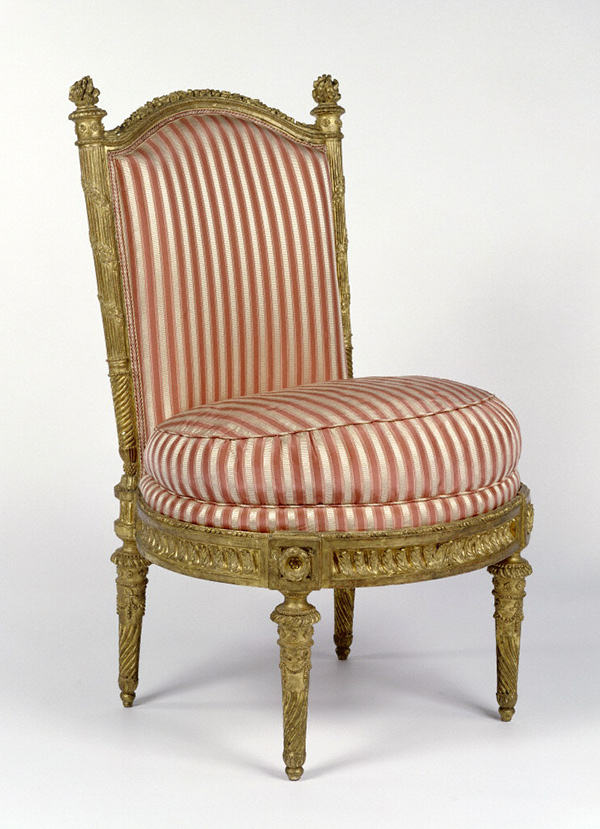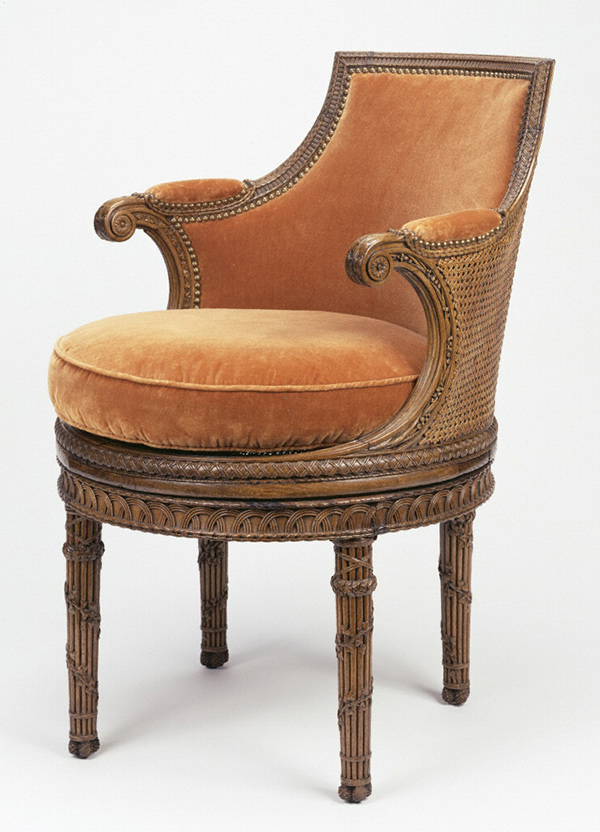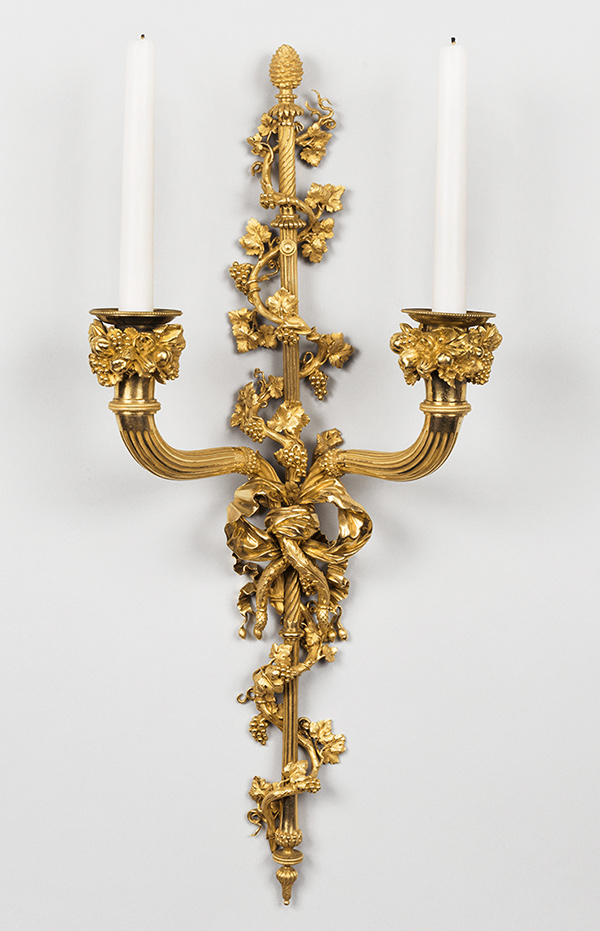
Queen Marie-Antoinette, about 1789, Pierre-Michel Alix after Elisabeth-Louise Vigée Le Brun. Etching and wash manner, printed in blue, red, yellow, and black inks, 9 3/16 x 7 1/16 in. The National Gallery of Art, Widener Collection, 1942.9.2. Image courtesy National Gallery of Art, Washington
Marie-Antoinette’s life came to an abrupt end under the guillotine on October 16, 1793. Yet her legacy is alive and well at the Getty Museum. France’s last Ancien Régime queen wielded an unparalleled influence on decorative arts in the late eighteenth century—leaving glittering traces in our galleries.
Marie-Antoinette, the Austrian archduchess who became queen of France at nineteen, remains a controversial figure. However, her contributions to the decorative arts were significant. She patronized the leading artists of her day, favoring the developing Neoclassical style—which was replacing the ornate Rococo—that drew inspiration from nature. Here are three objects that provide a window onto her life and artistic tastes at Versailles and at her private estate, the Petit Trianon.
1. A Side Chair Fit for a Queen

Side Chair, 1780–81, Jacques Gondoin, designer; frames by François-Toussaint Foliot; carved by Toussaint Foliot. Gilded beechwood; modern silk upholstery, 35 in. high. The J. Paul Getty Museum, 71.DA.93
One of four such pieces now at the Getty, this giltwood side chair formed a suite of eight side chairs and eight armchairs delivered to the Petit Trianon by master craftsman François II Foliot in 1781. Designed by Jacques Gondoin, they were used to furnish the salon du rocher, or rock salon, of an octagonal garden pavilion known as the Belvédère.
Marie-Antoinette invited her inner circle to take a seat on these chairs while enjoying music and tea in the salon du rocher, which looked out onto an ornamental lake and grotto. Carved torches emerging from ivy-bound sticks form the chair’s stiles, or vertical sides, and are reminiscent of those used to illuminate the Belvédère and other garden features for evening receptions. Marie-Antoinette’s brother, Holy Roman Emperor Joseph II, and the future Czar Paul I of Russia and his wife were received at Trianon in this manner.
2. Rural Simplicity for the Elegant Woman

Chair, about 1787, frame by Georges Jacob; carved by Pierre-Claude Triquet and Jean-Baptiste-Simon Rode. Beechwood, caning, and modern upholstery, 33 ½ in. high. The J. Paul Getty Museum, 72.DA.51
Compare the chair above to this one from the workshop of Georges Jacob, who was Marie-Antoinette’s favorite furniture maker by the 1780s. This armchair served an altogether different purpose. It is in fact a fauteuil de toilette, or dressing chair, capable of swiveling 360 degrees. It arrived at the Petit Trianon in 1787 and formed part of Marie-Antoinette’s bedchamber suite, almost all which can still be seen there today.
Although the chair is now stripped of its original color, it was originally painted a variety of naturalistic hues that highlighted whimsical details such as carved ivy and lily of the valley running along the arms and legs, wickerwork along the seat, and fir-cone feet. The brown velvet (a modern replacement) now hides any trace of the original cotton upholstery, which featured embroidered wool flowers.
The chair and the rest of the queen’s bedchamber furniture embodied the call for a return to nature and the rural simplicity sought by Marie-Antoinette. Sitting in this chair while having her hair dressed, she could enjoy the pastoral pleasures of Trianon even when indoors.
3. A Flame for the God of Wine

Wall Light, 1781, model by Claude-Jean Pitoin, designer; casting and chasing attributed to Louis-Gabriel Feloix, metalworker. Gilt bronze, 34 in. high. The J. Paul Getty Museum, 99.DF.20
Marie-Antoinette’s penchant for an idealized version of nature translated just as easily to her official staterooms at Versailles. This sconce or wall light, along with its three mates now also at the Getty, were modeled by the Parisian bronzer Claude-Jean Pitoin and illuminated the octagonal cabinet de la méridienne in the queen’s apartment at the château.
The sconce’s central shaft is a thyrsus, the mythological rod or staff belonging to Bacchus. Sinuous grapevines twist around the thyrsus, which is crowned by an upright pinecone, and the sconce’s arms, bound by a ribbon, take the shape of stylized cornucopia. Candles would have burst forth amidst a profusion of flowers, fruit, and leaves. Cast in bronze, these sconces’ lavishness is intensified by their gilding, achieved through a process combining gold with volatized mercury.
Luxury Goods of “France’s Last Tyrants”
Due to an accident of history, items associated with Marie-Antoinette are found in selected collections across Europe and the United States. After the fall of the French monarchy in 1792, the debt-ridden revolutionary government wasted no time in seizing former royal property and art collections for the nation, including those commissioned by the queen. Although some works were kept, others were sold at auction. Furniture, porcelain, small decorative objects, and other pieces known and loved by Marie-Antoinette were included in the sales of the “sumptuous furnishings of France’s last tyrants.”
The contents of Marie-Antoinette’s bedchamber at the Petit Trianon, including the swiveling armchair shown above, were sold on October 2, 1793, two weeks before her trial. Purchased by French and foreign buyers alike, the treasures of Versailles were scattered across Europe, with some eventually making their way to the United States.
At the Getty Museum we are fortunate to have acquired some of these rare items, which provide a glimpse into the life and legacy of a complex figure.




While I completely appreciate the J Paul Getty Museum’s GREAT fortune in acquiring these outstanding pieces, I wish that the museum would follow the example set by so many other museums and private collectors and return these historic artifacts to Versailles. Over the last fifteen years we have been fortunate enough to visit Versailles seven times, and each time we see many new artifacts that have been donated back to the Chateau of Versailles, the Petit Trianon and the Grand Trianon. These items should never been stolen or sold off during and after the French Revolution, and truly belong in the buildings they were created for. Please go to the official Versailles website and check out the acquisitions page – it’s incredible how many institutions like yours as well as private individuals return or sell these important artifacts to the Musee de Versailles.
Thank you for your comment and interest. We appreciate your taking the time to post and understand your concern.
The J. Paul Getty Museum and Versailles enjoy a longstanding relationship that includes a history of loans and professional collaboration in exhibitions and conservation endeavors. For over twenty years, the Getty has agreed to the permanent loan to Versailles of a desk made for Louis XVI. This piece, signed by Jean-Henri Riesener, was delivered to the king’s apartment at the Petit Trianon in the summer of 1777 and sold at auction in the 1790s. It is now back at Trianon, exhibited in its original location alongside a commode that was part of the same order.